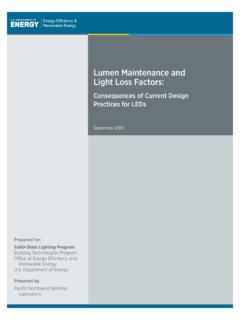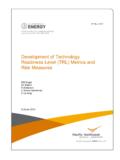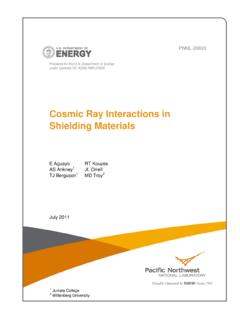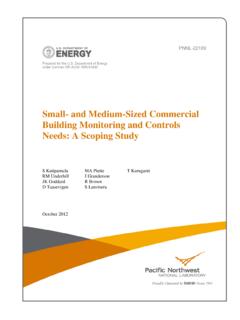Transcription of How to Implement Security Controls for an Information ...
1 How to Implement Security Controls for an Information Security Program at CBRN Facilities Action Implemented by With the support of UNICRI Project 19 How to Implement Security Controls for an Information Security Program at CBRN Facilities Prepared by the Pacific Northwest National Laboratory within the framework of the Project 19 of the European Union Chemical Biological Radiological and Nuclear Risk Mitigation Centres of Excellence Initiative (EU CBRN CoE) entitled: Development of procedures and guidelines to crate and improve Security Information management systems and data exchange mechanisms for CBRN materials under regulatory control. December 2015 With the support of Action Implemented by Pacific Northwest National Laboratory Richland, WA 99352 USA UNICRI, 2015 All rights reserved.
2 This document or parts thereof may be reproduced provided the source is referenced. The document has been produced with the assistance of the EU. The Information and views set out in this document are those of the author(s) and do not necessarily reflect the official opinion of the European Union. Neither the European Union institutions and bodies nor any person acting on their behalf may be held responsible for the use which may be made of the Information contained therein. The contents of this document do not necessarily reflect the views or policies of the United Nations, UNICRI or contributory organizations, or do they imply any endorsement. While reasonable efforts have been made to ensure that the contents of this document are factually correct and properly referenced, UNICRI does not accept responsibility for the accuracy or completeness of the contents, and shall not be liable for any loss or damage that may be occasioned directly or indirectly through the use of, or reliance on, the contents of this publication.
3 The designations employed and the presentation of material in this publication do not imply the expression of any opinion whatsoever on the part of the Secretariat of the United Nations and UNICRI concerning the legal status of any country, territory or boundaries. This publication has not been formally edited by UNICRI. iii Summary Information assets, including data and Information systems, need to be protected from Security threats. To protect their Information assets, chemical, biological, radiological, and nuclear (CBRN) facilities need to design , Implement , and maintain an Information Security program. The guidance provided in this document is based on international standards, best practices, and the experience of the Information Security , cyber Security , and physical Security experts on the document writing team. The document was developed within the scope of Project 19 of the European Union Chemical Biological Radiological and Nuclear Risk Mitigation Centres of Excellence Initiative.
4 This document is the third in a series of three documents produced by Project 19. The first document in the series, Information Security Best Practices for CBRN Facilities,1 provides recommendations on best practices for Information Security and high-value Security Controls . The second document in the series, Information Security Management System Planning for CBRN Facilities2 focuses on Information Security planning. It describes a risk-based approach for planning Information Security programs based on the sensitivity of the data developed, processed, communicated, and stored on facility Information systems. This document is designed to assist CBRN facilities in developing a comprehensive set of Security Controls to support the implementation of a risk-based, cost-effective Information Security program. A Security control is a safeguard or to protect the confidentiality, integrity, and availability of an Information asset or system and meet a set of defined Security requirements.
5 (NIST 2013). Security Controls cover management, operational, and technical actions that are designed to deter, delay, detect, deny, or mitigate malicious attacks and other threats to Information systems. The protection of Information involves the application of a comprehensive set of Security Controls that addresses cyber Security ( , computer Security ), physical Security , and personnel Security . It also involves protecting infrastructure resources upon which Information Security systems rely ( , electrical power, telecommunications, and environmental Controls ). The application of Security Controls is at the heart of an Information Security management system (ISMS). The selection and application of specific Security Controls is guided by a facility s Information Security plans and associated policies. Not all facilities can afford to purchase, install, operate, and maintain expensive Security Controls and related systems; therefore, decisions on the application of Security Controls have to balance considerations of Security risk and resource constraints.
6 When resources are limited, investments in Security Controls should focus on implementing a set of Controls that provide the greatest overall risk reduction given the 1 UNICRI - United Nations Interregional Criminal Justice Research Institute. 2015a. Information Security Best Practices for CBRN Facilities. United Nations Interregional Criminal Justice Research Institute, Turin, Italy. 2 UNICRI - United Nations Interregional Criminal Justice Research Institute. 2015b. Information Security Management System Planning for CBRN Facilities. United Nations Interregional Criminal Justice Research Institute, Turin, Italy. iv available resources. In this document, Security Controls are proposed for the following Information Security planning topic areas: Risk Assessment Risk Response Risk Monitoring Business Environment Asset Management Security Control Implementation Configuration Management Contingency Planning and Disaster Recovery Incident Response Monitoring and Auditing Awareness and Training.
7 For each topic area, Security Controls are presented along with the minimum risk level for the Information system at which the listed Security control should be applied. Also provided for each Security control are a summary rationale and its publicly available source. The major sources used are the Guide to Developing a Cyber Security and Risk Mitigation Plan1 and Critical Security Controls for Effective Cyber Defense, Version 52. After reviewing the various Security control options, a facility should select and Implement an appropriate set of Security Controls based on risk levels and resource constraint. These Security Controls should then be tracked to ensure they are appropriately used and maintained, and that the associated responsibilities, assignments, deliverables, and deadlines are documented. 1 NRECA - National Rural Electric Cooperative Association.
8 2014a. Guide to Developing a Cyber Security and Risk Mitigation Plan . NRECA / Cooperative Research Network Smart Grid Demonstration Project. Arlington, Virginia. Available by using the download tool at Accessed November 23, 2015. 2 Council on Cyber Security . 2015. Critical Security Controls for Effective Cyber Defense, Version 5. Accessed November 23, 2015 at v Acknowledgments This document was prepared by a team of cyber and Information Security researchers from the Pacific Northwest National Laboratory in the United States, the National Nuclear Laboratory in the United Kingdom, and the University of Glasgow in the United Kingdom. The members of the team are: Joseph Lenaeus Pacific Northwest National Laboratory Cliff Glantz Pacific Northwest National Laboratory Lori Ross O Neil Pacific Northwest National Laboratory Guy Landine Pacific Northwest National Laboratory Rosalyn Leitch Pacific Northwest National Laboratory Janet Bryant Pacific Northwest National Laboratory The European-based members of the team: John Lewis National Nuclear Laboratory Christopher Johnson University of Glasgow Gemma Mathers National Nuclear Laboratory Robert Rodger National Nuclear Laboratory The document s technical editor was Cornelia Brim (Pacific Northwest National Laboratory).
9 Administrative and management support was provided by Emily Davis, Josh Byrd, Monica Chavez, and Keith Freier (all of Pacific Northwest National Laboratory), and other members of the authors organizations. This document was produced within the scope of Project 19 of the European Union Chemical Biological Radiological and Nuclear Risk Mitigation Centres of Excellence Initiative. The initiative is implemented in cooperation with the United Nations Interregional Crime and Justice Research Institute and the European Commission Joint Research Center. The initiative is developed with the technical support of relevant international and regional organizations, the European Union Member States and other stakeholders, through coherent and effective cooperation at the national, regional, and international level. Special thanks to Odhran McCarthy and the staff at the United Nations Interregional Crime and Justice Research Institute for their support, patience, and technical guidance during this project.
10 Vi vii Acronyms and Abbreviations AES Advanced Encryption Standard ASD Australian Signals Directorate CA certificate authority CBRN chemical, biological, radiological, and nuclear CoE Centres of Excellence CSC Critical Security Control DHCP dynamic host configuration protocol DMZ demilitarized zone DNS domain name service EPRI Electric Power Research Institute ESCSWG Energy Sector Control System Working Group FTP file transfer protocol ID identification IDS intrusion detection system IEEE Institute for Electrical and Electronics Engineers IP Internet protocol IPS intrusion protection system IPsec Internet protocol Security ISMS Information Security management system IT Information technology NIST National Institute of Standards and Technology NRECA National Rural Electric Cooperative Association PKI public key infrastructure SDLC software development life cycle SIEM Security Information and event management SPF sender policy framework SQL Structured Query Language TCP transmission control protocol TLS transport layer Security UNICRI United Nations Interregional Crime and Justice Research Institute URL









